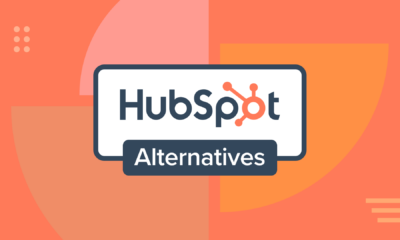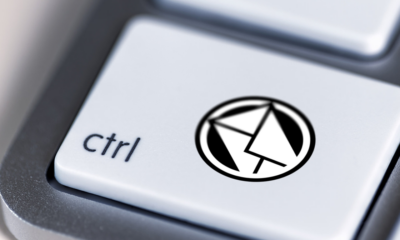EMAIL MARKETING
A Beginner’s Guide to Email Marketing
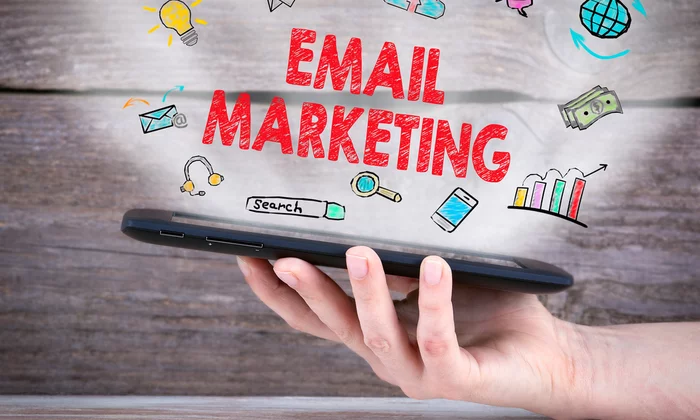
It may be one of the oldest forms of digital communication, but email still reigns supreme when it comes to usage.
Sure, there are other newer methods of communicating with your audience and customers. Communication methods like social media, live chat, and many others. However, with a user base of over 4 billion people, email is the king of marketing channels.
Additionally, email marketing has an ROI of $38 for every dollar spent, meaning it deserves a place in every marketer’s toolbox.
Email marketing is still ranked as the most effective marketing channel, beating out social media, SEO, and affiliate marketing.
Why is that? With all the hype over new channels, why is decades-old technology still one of the most effective marketing strategies?
Despite the rise of social, people use email more than other platforms. After all, what’s the good of marketing to someone if they’re not there?
Data shows that most people are on email—and the number increases every year.
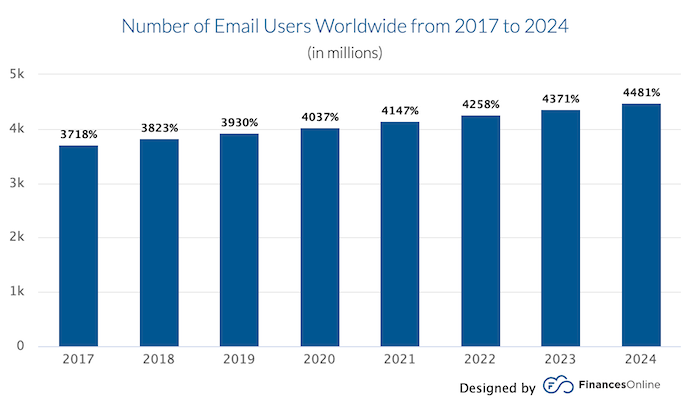
In addition, with email marketing you own the connections—you don’t have to worry about algorithm changes tanking your reach.
That’s why building a successful email marketing campaign is more important than ever.
There’s a problem—most people don’t know how to do it right. (In fact, you’ve probably seen those people in your email box.)
This post will walk you through tips and strategies for executing impactful email marketing campaigns.
What is Email Marketing?
Email marketing is the act of sending promotional messages to people in mass quantities. It typically is to generate sales or leads and it may contain advertising.
Remember: You’re a Guest in Their Inbox
People are inundated with interruptions, pitches, and advertisements everywhere they look.
Though you might think your email is special. To the reader, your email is one in a million—and not in a good way.
This is why it’s important to remember where you are and use good manners.
Getting into someone’s inbox is like being invited to their home for dinner. If they ask you to take your shoes off, you respectfully do so.
It’s the same with email marketing, so before we begin I’d simply like to remind you to be on your best behavior at all times and remember… you’re a guest in their inbox.
Now, let’s talk about how to build your email marketing strategy from the ground up.
How Does Email Marketing Work?
Email marketing is one of the top-performing strategies, in no small part because it’s fairly intuitive and often automated.
In its basic form, an effective email marketing campaign requires three essential elements:
1. An Email List
For you to pull off successful email campaigns, you need an active email list. This is a database of email contacts who have expressed interest in receiving marketing communications from your brand.
There are many ways to build an email list. One of the easiest is to create a lead magnet (also called an offer) your target audience is interested in, like a coupon, in exchange for their email addresses.
2. An Email Service Provider
An email service provider (ESP), also known as an email marketing platform, is software that helps manage your email list. It also helps design and execute automated email marketing campaigns.
Using an ESP allows you to automate actions triggered by your target audience’s behaviors. These enable you to personalize each interaction with them, meaning engagement and conversion rates generally improve.
3. Clearly Defined Goals
You can use email marketing to achieve many business goals. For example, you can use email marketing to:
- drive sales
- boost brand awareness
- generate and nurture leads
- keep customers engaged
- increase customer loyalty and lifetime value
To execute an effective email marketing campaign, your email list, ESP, and goals must align. Then, you can get to work.
The first step is to segment your email list according to subscriber demographics or actions.
Next, create an email or series of emails designed to get consumers to do something (your goal).
Finally, use your ESP to send emails and monitor the campaign automatically.
Advantages and Disadvantages of Email Marketing
Just like any other marketing channel, email marketing has pros and cons. Let’s briefly dive into some of the more significant ones:
Advantages of Email Marketing
Email Is Permission-based
When a customer trusts you with their email address, it’s the virtual equivalent of being given the keys to their house. Gaining permission to enter rather than showing up uninvited increases the chances of engagement and conversion.
Affords You Direct Access to Your Audience
You can communicate directly with subscribers on their schedules. In addition, because people check their emails daily, your email is likely to be viewed.
Gives You More Control
With most other marketing platforms, you don’t own the platform. If the platform ceases to exist, all your hard work sinks with it.
With email, you own the relationships you forge with your subscribers.
More Personalization Capabilities
You can use demographic or psychographic data to create personalized and hyper-targeted campaigns. Research shows segmented and personalized campaigns increase revenue by as much as 760 percent.
Measurable
Measuring the effectiveness of a marketing campaign is crucial, and automated email marketing makes measuring your campaign a breeze.
Scalable
Email marketing campaigns can scale without putting a strain on your resources or compromising quality.
Disadvantages of Email Marketing
Tough Competition
Standing out in a cluttered inbox can be quite a challenge. You have to be creative to ensure your emails get noticed and opened.
You Need an Email List
With email marketing, you must already have an email list for your campaigns to be effective.
Tricky Rules and Regulations to Navigate
There are a lot of rules governing the use of email for commercial purposes. Common examples include GDPR, CAN-SPAM, and CCPA. All of these state you can’t send unsolicited emails.
Unfortunately, some subscribers also report your emails as being spam even after they subscribed to the list. As a result, your sender reputation takes a hit.
Delivery and Deliverability Issues
Getting your email to land in receivers’ inboxes is not guaranteed. To run effective email marketing campaigns, you must contend with delivery and deliverability issues.
Email Marketing Examples
Let’s briefly look at a couple of email marketing examples for a bit of inspiration.
Teaonic
Teaonic is an e-commerce brand specializing in organic, healthy teas.
Subject line: Getting Low On Wellness?
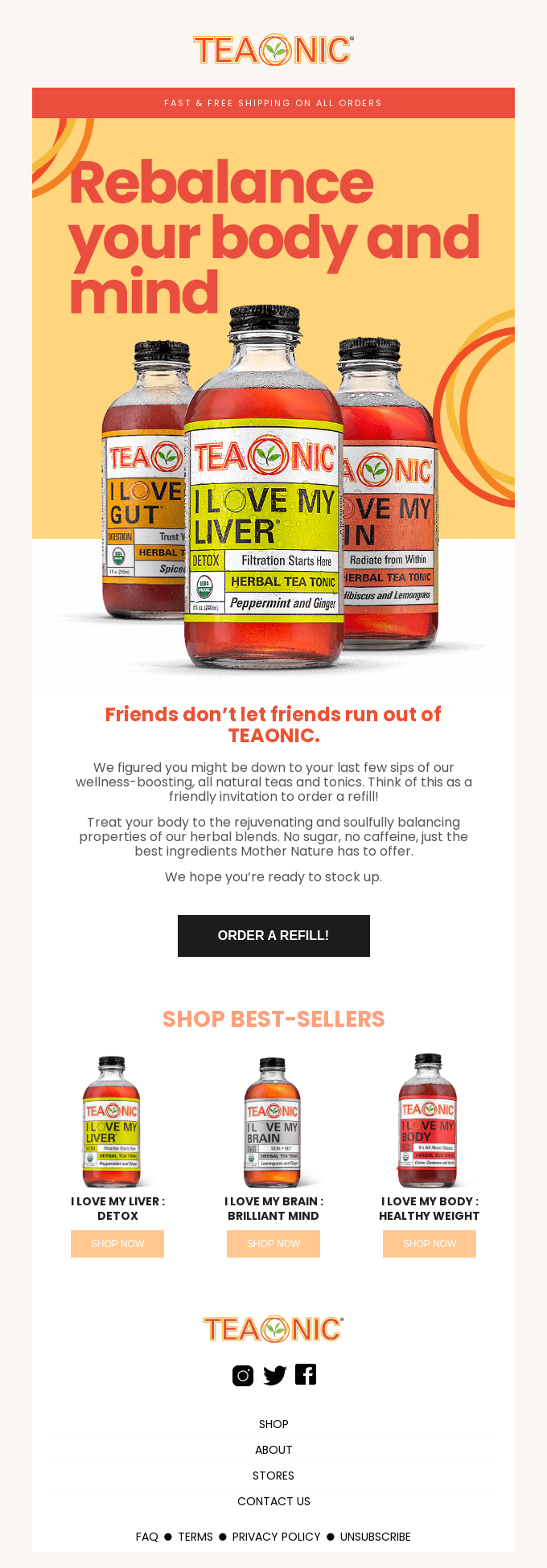
What does this email get right?
- Great subject line: The subject line focuses on the target audience’s main pain point, i.e., improving their health.
- Leverages color psychology: The bright, warm colors trigger feelings of health and happiness.
- Well-timed: The email is targeted at people who have purchased the product and is sent when the customer’s supply is about to run out.
Bluehost
Well-known for its hosting services, Bluehost decided to try its hand at creating a website builder.
Subject line: Bluehost’s new Website Builder makes building simple.

- Sells the benefits, not features: Focusing on the benefits makes the copy more compelling.
- Clean design: The simple design makes the email aesthetically pleasing and easy to read.
- Excellent targeting: Bluehost knows their audience is mainly made up of small business owners without technical expertise. The email uses language targeted at this demographic.
How to Automate Your Email Marketing
While the automation process varies from one ESP to another, there are some universal steps to automating your email marketing.
Define Your Segments
Effective email marketing campaigns start with list segmentation. Use the data you have about your subscribers to group them. This allows you to create more personalized campaigns.
Design an Efficient Workflow
After segmenting your email list, it’s time to design a workflow. This is the series of emails to fulfill the objective of the campaign.
Determine the Right Triggers
Once you’ve designed your workflow, determine the triggers that will set off the following email in the sequence. Examples of triggers can include customers opening your email, clicking on a link, or not opening it at all within a predetermined time frame.
Best Email Marketing Strategies
To succeed with email marketing, you have to be strategic in the way you design your campaigns. Here are some of the best email marketing strategies you can employ.
Use the Right List Building Strategies
The success of your email marketing campaigns depends on the quality of your email list. To build such a list, you must use list-building strategies designed to attract your target audience. For example, a case study promoted on LinkedIn may help a B2B brand build a list of engaged subscribers but flop when used by a B2C brand.
Practice Good Email List Hygiene
Another essential email marketing strategy is practicing good email list hygiene. Cleaning out inactive subscribers and email addresses that are no longer in use will ensure you have a good sender reputation.
Keep Your List Warm
Regularly send emails to your list to keep your subscribers engaged (warm). However, sporadic emailing could result in subscribers forgetting who you are and lead to low conversion rates.
If some of your subscribers go cold, you can run a re-engagement campaign.
Focus on One Objective
Design each campaign and email to focus on one objective. Trying to kill two (or more) birds with one stone doesn’t work with email marketing. It only confuses your audience and reduces your conversion rates.
Define and Track the Right KPIs
Email marketing is more than sending your subscribers a couple of emails. It also entails tracking the performance of your campaigns. To do so, you must define and track the right key performance indicators (KPIs).
Top 7 Email Marketing Tools Every Marketer Should Know
To pull off a successful campaign, you need to leverage email marketing tools to optimize your processes. Here are the top seven you should know:
Email Service Providers (ESP)
One of the most critical email marketing tools you need is an ESP. Some top ESPs are:
- Constant Contact: This is best for e-commerce email marketing campaigns, thanks to features like automated product recommendations and shoppable emails. Plans start at $20/month.
- Sendinblue: Sendinblue is best for small businesses running simple email campaigns. It has a rich feature set with a CRM, live chat, and SMS, among others. Plans start at $25/month.
- Pardot: B2B email campaigns require a platform specifically designed for the B2B buyer journey. Pardot fits the bill perfectly. However, to build high-growth email campaigns with Pardot, be prepared to part with at least $1,250/month.
Deliverability Tools
Email deliverability refers to the ability of an ESP to place emails in your receivers’ inboxes successfully. The wise email marketer will have an email deliverability tester in their toolbox. Here are some of the top ones:
- MailGenius: MailGenius inspects your emails for possible spam triggers. You can use it to run deliverability tests to ensure your emails reach their intended recipients’ inboxes. MailGenius is a free tool.
- GlockApps: GlockApps shows your delivery results in real-time, including whether your email landed in the Inbox, Spam folder, Gmail’s Promotional or Social tabs, or if it was never delivered at all. Personal accounts are free, and prices go up from there.
Testing and Tracking
Testing and tracking the campaign performance helps you create optimized iterations of your campaigns. Which email marketing tools are best for testing and tracking?
- Litmus: You can use Litmus to test and track your emails in traditional web clients and popular mobile devices.
Email Personalization Tools
Take your personalization game beyond just using your recipients’ name by using a personalization tool.
- Hyperise: When it comes to personalizing email marketing campaigns, no tool does it better than Hyperise. It helps you add dynamic, personalized images to each of your emails, including profile images from social media platforms.
How to Write Email Marketing Copy That Drives Results
Whatever your email marketing goal is, it all hinges on email marketing copy.

That’s why you must write yours well. To do that:
Know Your Audience
The first step to crafting compelling email marketing copy is knowing your audience. This will help you better segment your list and create hyper-targeted email copy.
Craft a Hard-to-Ignore Subject Line
The subject line is one of the most important elements of email copy as it helps readers decide whether to open your email. To craft a hard-to-ignore subject line:
- use keywords
- make it benefit-driven
- use active voice
- personalize as much as possible
Get the Preview Text Right
Email preview text appears immediately below or beside the subject line. Limited to a maximum of 140 characters (email client dependent), it acts as an elevator pitch to convince people to open your email. An optimized preview text is an extension of your subject line and reinforces your value proposition.
Make It Easy to Read
People are busy. That’s why you should write your email copy so it’s easy to read and understand. Do this by:
- using short sentences and paragraphs
- avoiding jargon and complicated words
- using bullet points
If your readers find your emails easy to read, they’ll likely engage with them more.
Leverage Storytelling
Stories are a powerful way to grab attention and get your message across. That’s why you should leverage storytelling in your email copy.
Use Psychology to Your Advantage
Human beings are wired to react in specific ways. Use psychological triggers to direct your readers towards fulfilling your campaign objectives. Examples of such triggers include:
- fear of missing out (FOMO)
- color psychology
- social proof
Used well, these triggers can help you craft email effective copy.
Email Marketing Step 1: Build Your List
Before you can start sending out emails, you need people to send emails to. How do you get started building your list? Start by adding a banner or form to your website simply asking people to subscribe.
Then, follow these tips.
1. Offer An Incentive
Think of email addresses as a currency: you wouldn’t give money away for free, right? Offering an incentive is the simplest way to gather email addresses.
There are many ways you can do this, of course. Some prefer to give something away for free while others simply offer a newsletter or product updates.
For example, the business newsletter Morning Brew offers readers a simple benefit: their fun, interesting updates every morning.
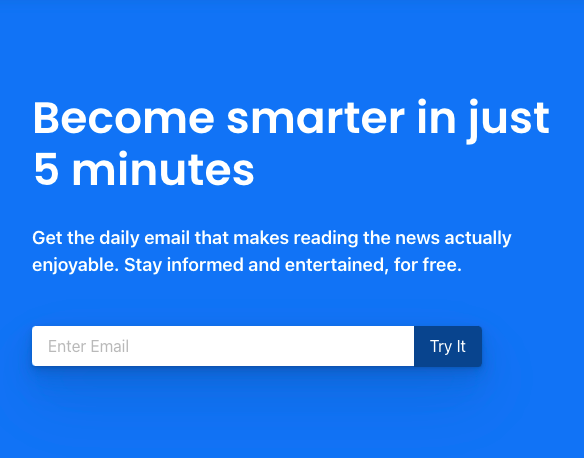
Search Engine Journal uses a small form in their right sidebar offering daily news—they also ask which topics the user is interested in, which helps them send more valuable content.
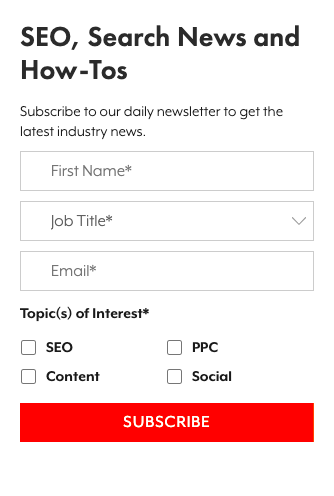
You can also offer a checklist, ebook, white paper, or another downloadable asset. Contests and giveaways are another great way to convince people to share their email addresses.
I can’t tell you which is the right or wrong path for your business, but I can tell you that it’s important to have a clear purpose when asking for an address.
This is where a strong call to action comes into play, and copywriting is super important.
Establish your credibility, explain what the emails are for, and get people interested in receiving them.
Simply posting “enter your email for updates” isn’t going to get anyone excited. Instead, share specifics.
By sharing a specific call to action or benefit to providing their email address, you can get more people to subscribe.
Some common ways to entice people to sign up include:
- email series
- free downloads
- free white papers or eBooks
- update lists, like new releases and product updates
Whatever that incentive is, make it clear and enticing, and don’t be afraid to promote it.
2. Follow Email Marketing Laws and Regulations
You’ll also want to make sure your emails follow local rules and regulations, including CAN-SPAM and GDPR.
Don’t let all the legalese scare you—just make sure you never buy email lists and consider using double opt-in options so people know what they are getting into. Finally, make it easy for people to unsubscribe.
Email Marketing Step 2: Provide Great Content
Email marketing is all about expectations, and it’s up to you to set them.
If your call to action is strong, and your follow-up is consistent, then you can count on a successful email campaign.
However, if you promise to send one email per week and instead send them daily, then you’re setting yourself up for failure.
On the contrary, if someone is expecting daily updates or critical product updates and you don’t deliver, then they are likely to be just as upset in that case, too.
This is why the first follow-up email is so crucial to the success of your email marketing efforts.
Send an Introduction Email
For example, here’s a basic welcome email from Airbnb to a new host. It explains the basics of the process and what you can expect to receive from Airbnb.
Spotify sends out a similar email that confirms the subscription and lets them know what they can expect.
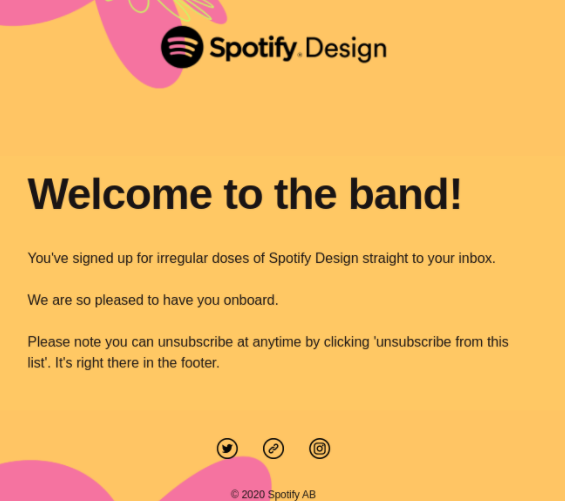
Almost all email service providers give you the option to create an automated welcome sequence, so take advantage of it.
The initial follow-up email should be sent immediately as a way to introduce yourself and detail what you plan on doing with your new subscriber’s email address.
It’s better to be long-winded and detailed than it is to be quick and unobtrusive, but if you can pull off quick and concise, then more power to you.
From here, it’s simply a matter of living up to their expectations.
Don’t Pitch Right Away
You’re not running an email list just for the fun of it—you’re there to engage customers and make sales.
Transitioning from an email list that provides tons of free value into a list that pitches a product for money can be a tricky switch to make.
To do it effectively, it’s a good idea to think in advance about your pitching. You don’t want to surprise everyone with a pitch all of the sudden.
You’ll have a much more successful campaign if people expect sales pitches every once in a while.
If you’re going to get in the habit of selling often, try to put yourself in the reader’s shoes.
Ask yourself if your messaging is consistent with the expectations you’ve set. If possible, understand what the customer has shown interest in before, and send similar offers down the line.
Those that send blind offers are far more likely to lose permission to keep doing so.
Again, each business has different needs, and there aren’t any hard and fast rules as to how often you can pitch or provide content.
Just remember that an email list is a permission asset and it’s better to err on the side of caution than to play it loose and reckless.
How to Write a Great Email Newsletter
Let’s talk about the difference between a good newsletter and a bad newsletter.
The first sign that you’ve received a bad newsletter is that you don’t recall ever asking to receive it.
Typically, this happens when a business either fails to maintain a regular email routine or manually adds someone to their list after receiving a business card or personal email.
Make sure everyone remembers you—the best way to do this is not to let your emails lapse for too long. Try to send an email at least once a month, or once a week if you can.
I find the most compelling newsletters are those that do a great job of mixing messaging and updates.
For example, while the email might contain a list of product updates and images, it’s balanced by a personal message or friendly memo.
Use your newsletter as a way to further your relationship with the reader/customer rather than to pitch them.
Save the pitch for unique updates, offers, and announcements.
Use Email Automation Carefully
If you’re just starting out with an email list, it’s easy to imagine you’ll have time to personally respond to every new subscriber.
Once you start getting more than a handful of subscribers, it becomes next to impossible to keep up.
You’ll start to get more and more complex campaigns, and following through with everyone all the time is impossible.
Top marketers seem to do this exact thing. How?
Their secret is email automation.
It automatically sends out emails that you schedule in advance.
By scheduling a set of emails to send in advance, you can prevent “going dark” for any length of time.
Oftentimes, companies plan out a series of emails—ranging from a few days to a few months—that automatically deliver, warming up anyone who signs up for your list.
That way, when you do need to announce a new product or sale, you can count on the fact that they are paying attention.
Since you’ve built up a relationship over several weeks or months, you’re much less likely to annoy your readers.
Email Marketing Step 3: Analytics and Segmentation
Now that you understand the basics behind an effective email campaign, let’s talk about how to take things to the next level.
Specifically, using segmentation and analytics to refine your broadcasts and generate even better results than a basic campaign.
How To Understand Email Analytics
We’ve talked before about the importance of analytics in web copy, and email is no different.
Every email service provider I’ve ever worked with provides complimentary analytics.
Though they’re all important, the three most important are open rate, click-through rate, and unsubscribes. Let’s break down each one and see what there is to learn from it.
First, your open rate explains how many people open your emails. It’s based on a single invisible tracking pixel that loads when someone clicks on your message.
When looking at open rates, it’ll usually tell you how well you’ve built your relationship with readers. Ideally, people are excited to read your emails and open them quickly.
If your open rate is low, it usually means you have a lot of unengaged subscribers. You need to work harder on providing value and managing expectations. Here are a few tips on raising your open rate.
Next, your click-through rate, or CTR, shows how many people clicked on a link (if any) in your email.
If your CTR is low, it means that your message is either not targeted enough, or simply not getting through. In this case, focus on improving your copy.
Finally, your unsubscribe rate tells you how many people have clicked the “unsubscribe” button at the bottom of your email.
If your unsubscribe rate is high in relation to your opt-in rate, then you’ve passed the point of building value and writing good copy… you’ve got some serious work to do.
Essentially you’ve built a sieve and people that sign up eventually leave. If this is you, try to examine when people are leaving and take action based on those leaks.
If they’re leaving after a certain automated email, then re-work it. If they’re leaving after marketing messages, then re-work the way you present offers.
If they’re leaving early on in your email funnel, then you need to fix your original call to action so that it’s in harmony with what you’re sending.
Email analytics are critical because, if you’re paying attention, they’ll give you very specific clues as to what you’re doing wrong.
Of course, the key here is “paying attention.”
How To Segment Your Email Marketing List
If you’re unfamiliar with the term, email segmentation is the practice of splitting up your email list into more targeted groups.
Here are a few ways to segment a larger list:
- customer list (in comparison to leads who haven’t bought)
- newsletter subscribers
- daily email list (in comparison to weekly, bi-weekly, monthly, etc)
- demographics, such as age, location, or job title
- interests, such as marketing or sales topics
Just like targeting in paid ads, dividing your list gives you the ability to send more targeted communications.
For example, some customers want both product and sales updates, while others might only want to hear about new versions. Sales team leads might want to hear about a new sales feature but not a new marketing tool.
Plus, you can send specific emails to buyers thanking them for their purchase, like this email from Chrome Industries thanking people for making a purchase.
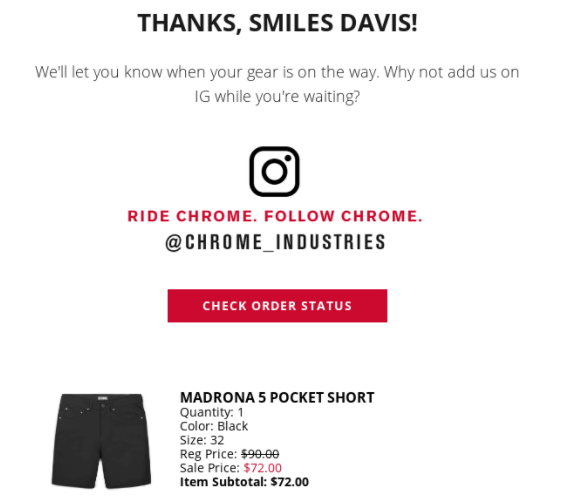
With segmentation, you can send a broadcast only to those that didn’t open your last message (ask them why), or to those that showed interest (a second pitch).
You can also split test messaging amongst different groups to A/B test titles, content, or best practices.
As you can see, segmentation isn’t rocket science, but it is work, which is why most don’t take the time to do it right.
If you do, you’ll immediately separate yourself from the pack.
How Much Is Your Email List Worth?
Your email list is one of your most valuable resources, and if you learn how to treat it right, it will pay for itself many times over.
Over time, you can start tracking how much money people on your list spend on average. This will tell you how much your list is worth.
If a list of 10,000 people usually spends $50,000 on a campaign, and you run two of those campaigns each year, you could average it out and say that each subscriber is worth $10 a year.
When you do the math like that, it is easy to see how losing several hundred subscribers could be dangerous to your bottom line.
Email Marketing FAQs
What are the benefits of email marketing?
Email marketing can help businesses reach a wider audience, drive sales, recover abandoned carts, and further develop your relationship with your audience.
How do I build an email list?
You can offer a downloadable asset, host a giveaway, or provide a free email course.
What email marketing regulations are there?
CAN-SPAM and GDPR (for Europe) require you to protect user’s privacy and avoid sending emails to purchased lists.
What is email automation?
Email automation allows you to create complex email campaigns that send emails based on actions, such as when a subscriber adds an item to their cart or downloads an asset.
How do I segment my email list?
Use your email tool to split subscribers based on demographics, interests, or customers versus non-customers. Then, send customized messages to each segment.
Email Marketing Conclusion
If you’ve been ignoring email marketing, it’s time to reevaluate your strategy.
Email marketing delivers huge returns for marketers willing to learn how to do it right. It doesn’t have to be too complicated.
First, remember you’re a guest in the inboxes of your subscribers. Your emails are always just one click away from losing their interest forever. Be polite, respectful, and deliver value.
As you get started, you’ll need to ask permission. Of course, it’s the right thing to do. In the era of new data protections, like the EU’s GDPR, it’s also a legal requirement.
You’ll want to follow through with the promises you make. Provide people with what they’ve asked for and email regularly to line up with their expectations.
There’s no formula for boosting email automation. It’s all about what works best for you and your company’s voice and style.
Finally, you can move on to email segmentation and analytics once you’ve mastered the basics. Start sending separate types of emails to different groups of people so you can deliver more useful emails.
What email marketing practices keep your readers engaged?
See How My Agency Can Drive Massive Amounts of Traffic to Your Website
- SEO – unlock massive amounts of SEO traffic. See real results.
- Content Marketing – our team creates epic content that will get shared, get links, and attract traffic.
- Paid Media – effective paid strategies with clear ROI.







